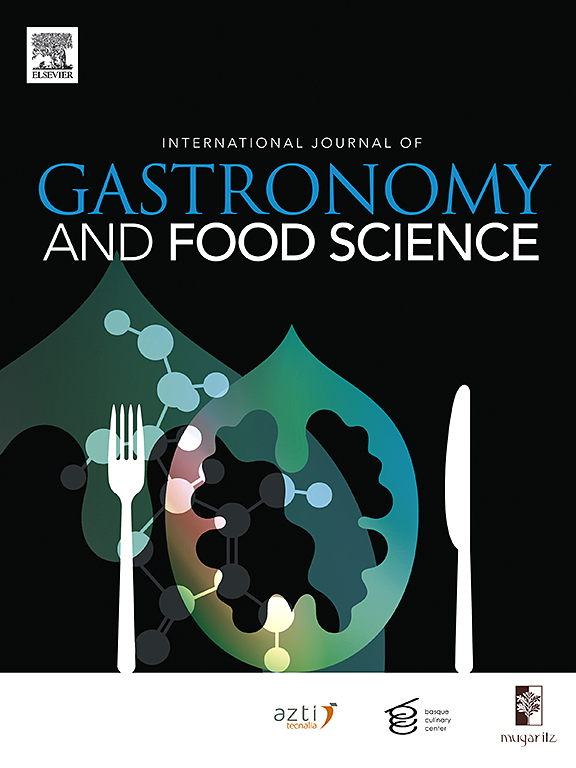菊芋对水开非尔生产微生物和化学特性的影响
IF 3.2
2区 农林科学
Q2 FOOD SCIENCE & TECHNOLOGY
International Journal of Gastronomy and Food Science
Pub Date : 2025-01-08
DOI:10.1016/j.ijgfs.2025.101104
引用次数: 0
摘要
本研究的目的是评估以耶路撒冷洋蓟(JA)为基础的水开菲尔的微生物,化学和感官属性,这是一种旨在生产合成饮料的新配方。添加JA后,发酵36 h后初始pH为7.14,发酵36 h后pH降至3.59,而对照组pH从7.51降至5.28。同样,基于ja的样品的可滴定酸度增加到0.89 g/L,而对照组为0.62 g/L,酸化速率没有统计学上的显著差异(p >;0.05)。加ja水开菲尔的乳酸杆菌数量显著增加,乳杆菌和乳球菌数量分别达到8.52和7.14 log CFU/mL,而对照组为5.65和5.57 log CFU/mL。DGGE分析证实了这一趋势,揭示了发酵结束时基于ja的样品中更多样化的LAB群落。值得注意的是,在ja基水开菲尔中,肠系膜Leuconostoc mesenteroides成为了优势的LAB物种,在发酵结束时约占LAB种群的65%,其数量达到5.54 log CFU/mL,而乳酸杆菌sp的总数量为8.52 log CFU/mL。在化学成分方面,ja基水开菲尔中鉴定出的主要挥发性化合物包括乙酸乙酯、3-甲基-1-丁醇、苯乙醇、壬酸、癸酸和肉豆汁酸。此外,JA的添加显著增加了水开菲尔中菊粉和低聚果糖(FOS)等益生元化合物的存在,其果聚糖含量在发酵过程中达到0.546 g/100 mL。发酵过程中果聚糖含量与乳酸菌生长呈显著正相关(乳杆菌的Pearson’s r = 0.92,总乳酸菌的r = 0.89),说明JA对发酵过程和微生物增殖有影响。主成分分析(PCA)表明,JA作为底物的利用率与发酵时间呈显著相关。综上所述,耶路撒冷洋蓟果聚糖含量达到0.546 g/100 mL,可作为水开菲尔发酵的重要底物,使饮料中富含菊粉型果聚糖,并与增强的LAB增殖相结合,建立其共生性质。本文章由计算机程序翻译,如有差异,请以英文原文为准。
Influence of Jerusalem artichoke on microbial and chemical characteristics of water kefir production
The objective of this study is to assess the microbiological, chemical, and sensory attributes of Jerusalem artichoke (JA) based water kefir, a novel formulation aimed at producing a synbiotic beverage. The addition of JA resulted in an initial pH of 7.14, which decreased to 3.59 after 36 h of fermentation, compared to a decrease from 7.51 to 5.28 in the control sample. Similarly, the titratable acidity increased to 0.89 g/L in the JA-based sample versus 0.62 g/L in the control, with no statistically significant difference observed in the acidification rate (p > 0.05). The JA-based water kefir exhibited significantly higher LAB populations, with Lactobacillus sp. and Lactococcus sp. counts reaching 8.52 log CFU/mL and 7.14 log CFU/mL, respectively, compared to 5.65 log CFU/mL and 5.57 log CFU/mL in the control. DGGE analysis confirmed this trend by revealing a more diverse LAB community in the JA-based sample at the end of fermentation. Notably, Leuconostoc mesenteroides emerged as the dominant LAB species in JA-based water kefir, representing approximately 65% of the LAB population at the end of fermentation, with its count reaching 5.54 log CFU/mL out of the total 8.52 log CFU/mL for Lactobacillus sp. Regarding chemical constituents, the principal volatile compounds identified in JA-based water kefir included ethyl acetate, 3-Methyl-1-butanol, Phenethyl alcohol, nonanoic acid, capric acid, and myristic acid. Furthermore, the addition of JA to water kefir significantly increased the presence of prebiotic compounds such as inulin and fructooligosaccharides (FOS), as evidenced by the fructan content, which reached 0.546 g/100 mL during fermentation. A strong positive correlation was observed between the fructan content and LAB growth during fermentation (Pearson's r = 0.92 for Lactobacillus sp. and r = 0.89 for total LAB counts), demonstrating the impact of JA on the fermentation process and microbial proliferation. Principal Component Analysis (PCA) revealed a significant correlation between the utilization of JA as a substrate and the duration of fermentation. In conclusion, Jerusalem artichoke, with its fructan content reaching 0.546 g/100 mL, serves as a significant substrate for water kefir fermentation, enriching the beverage with inulin-type fructans and, combined with enhanced LAB proliferation, establishing its symbiotic nature.
求助全文
通过发布文献求助,成功后即可免费获取论文全文。
去求助
来源期刊

International Journal of Gastronomy and Food Science
Social Sciences-Cultural Studies
CiteScore
5.30
自引率
10.50%
发文量
170
审稿时长
45 days
期刊介绍:
International Journal of Gastronomy and Food Science is a peer-reviewed journal that explicitly focuses on the interface of food science and gastronomy. Articles focusing only on food science will not be considered. This journal equally encourages both scientists and chefs to publish original scientific papers, review articles and original culinary works. We seek articles with clear evidence of this interaction. From a scientific perspective, this publication aims to become the home for research from the whole community of food science and gastronomy.
IJGFS explores all aspects related to the growing field of the interaction of gastronomy and food science, in areas such as food chemistry, food technology and culinary techniques, food microbiology, genetics, sensory science, neuroscience, psychology, culinary concepts, culinary trends, and gastronomic experience (all the elements that contribute to the appreciation and enjoyment of the meal. Also relevant is research on science-based educational programs in gastronomy, anthropology, gastronomic history and food sociology. All these areas of knowledge are crucial to gastronomy, as they contribute to a better understanding of this broad term and its practical implications for science and society.
 求助内容:
求助内容: 应助结果提醒方式:
应助结果提醒方式:


